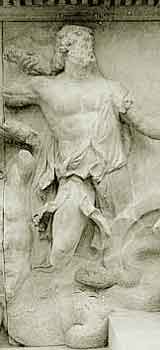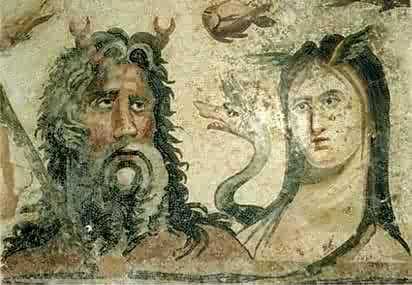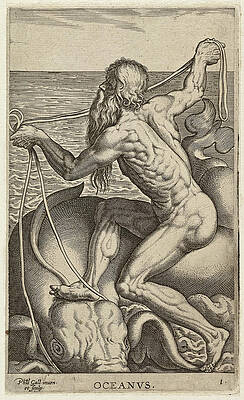.
Some think that even the ancients who lived long before the present generation, and first framed accounts of the gods, had a similar view of nature; for they made Ocean and Tethys the parents of creation, and described the oath of the gods as being by water, to which they give the name of Styx; for what is oldest is most honourable, and the most honourable thing is that by which one swears. Aristotle, Metaphysics

Oceanus from the Pergamon Zeus Altar
Oceanus or Okeanos refers to the ocean, which the Greeks and Romans regarded as a river circling the world. Strictly speaking, it was the ocean-stream at the Equator in which floated the habitable hemisphere (oikoumene)[1] (http://www.metrum.org/mapping/cosmol.htm). In Greek mythology this world-ocean was personified as a Titan, a son of Uranus and Gaia. In ancient Greek beliefs this Titan is often depicted as having the upper body of a muscular man with a long beard and horns, and the lower torso of a serpent. (Compare Typhon.)
Oceanus' consort is his sister Tethys, and from their union came the ocean nymphs, also known as the three-thousand Oceanids, and all the rivers of the world.
Some scholars believe he originally represented all bodies of salt water, including the Mediterranean Sea and the Atlantic Ocean, the two largest bodies the ancient Greeks knew of. However, as geography became more accurate, Oceanus came to represent the stranger, more unknown waters of the Atlantic Ocean (also called the Ocean Sea) while Poseidon ruled over the Mediterranean.
In most variations of the war between the Titans and the Olympians ("Titanomachy"), Oceanus, along with Prometheus, and Themis, did not take the side of their fellow Titans against the Olympians, but instead withdrew from the conflict. In most variations of this myth Oceanus also did not side with Cronus in his revolt against Uranus.
In Iliad the rich iconography of Achilles' shield that Hephaestus made, is enclosed, as the world itself is, by Oceanus:
"Then, running round the shield-rim, triple-ply,
he pictured all the might of the Ocean stream."
Oceanus appears in Hellenic cosmography as well as myth. Cartographers continued to represent the encircling equatorial stream much as it had appeared on Achilles' shield [2] (http://www.metrum.org/mapping/cosmol.htm).
Though Herodotus was skeptical about the physical existence of Oceanus, he rejected snowmelt as a cause of the annual flood of the Nile; according to his translator and interpreter Livio Catullo Stecchini he left unsettled the question of an equatorial Nile, extending from the true sources of the Nile to the Atlantic Ocean.
Oceanus, Hendrik Goltzius
The sea god Oceanus, seated on a sea elephant, Philip Galle
See also : Greek Mythology. Paintings, Drawings
Greek Mythology Index
A - B - C - D - E - F - G - H - I - J - K - L - M -
N - O - P - Q - R - S - T - U - V - W - X - Y - Z
Α - Β - Γ - Δ - Ε - Ζ - Η - Θ - Ι - Κ - Λ - Μ -
Ν - Ξ - Ο - Π - Ρ - Σ - Τ - Υ - Φ - Χ - Ψ - Ω
| Ancient Greece
Science, Technology , Medicine , Warfare, , Biographies , Life , Cities/Places/Maps , Arts , Literature , Philosophy ,Olympics, Mythology , History , Images Medieval Greece / Byzantine Empire Science, Technology, Arts, , Warfare , Literature, Biographies, Icons, History Modern Greece Cities, Islands, Regions, Fauna/Flora ,Biographies , History , Warfare, Science/Technology, Literature, Music , Arts , Film/Actors , Sport , Fashion --- |
Retrieved from "http://en.wikipedia.org"
All text is available under the terms of the GNU Free Documentation License




